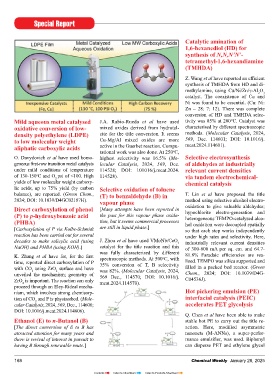Page 168 - CW E-Magazine (28-1-2025)
P. 168
Special Report
Catalytic amination of
1,6-hexanediol (HD) for
synthesis of N,N,N’N’-
tetramethyl-1,6-hexandiamine
(TMHDA)
Z. Wang et al have reported an efficient
synthesis of TMHDA from HD and di-
methylamine, using Cu/Ni/Zn/γ-Al O 3
2
catalyst. The coexistence of Cu and
Ni was found to be essential. (Cu: Ni:
Zn = 28: 7: 12). There was complete
conversion of HD and TMHDA selec-
Mild aqueous metal catalysed J.A. Rubio-Rueda et al have used tivity was 85% at 200°C. Catalyst was
oxidative conversion of low- mixed oxides derived from hydrotal- characterised by different spectroscopic
density polyethylene (LDPE) cite for the title conversion. It seems methods. (Molecular Catalysis, 2024,
to low molecular weight Cu-Mg/Al mixed oxides are more 569, Dec. 114601; DOI: 10.1016/j.
aliphatic carboxylic acids active in the Guerbet reaction. Compu- mcat.2024.114601).
o
tational work was also done. At 250 C,
O. Davydovich et al have used homo- highest selectivity was 16.5% (Mo- Selective electrosynthesis
geneous first-row transition metal catalysts lecular Catalysis, 2024, 569, Dec. of aldehydes at industrially
under mild conditions of temperature 114528; DOI: 101016/j.mcat.2024. relevant current densities
of 130-150 C and O psi of <100. High 114528). via tandem electrochemical-
o
2
yields of low molecular weight carboxy- chemical catalysis
lic acids, up to 75% yield (by carbon Selective oxidation of toluene
balance), are reported. (Green Chem., (T) to benzaldehyde (B) in T. Lin et al have proposed the title
2024; DOI: 10.1039/D4GC02187H). vapour phase method using selective alcohol electro-
Direct carboxylation of phenol [Many attempts have been reported in oxidation to give valuable aldehydes;
hypochlorite electro-generation and
(P) to p-hydroxybenzoic acid the past for this vapour phase oxida- heterogeneous TEMPO-catalysed alco-
(PHBA) tion, but it seems commercial processes hol oxidation were decoupled spatially
[Carboxylation of P via Kolbe-Schmidt are still in liquid phase.] so that each step works independently
reaction has been carried out for several under high rates and selectivity. Here,
decades to make salicylic acid (using J. Zhou et al have used VMoNb/CeO industrially relevant current densities
2
NaOH) and PHBA (using KOH).] catalyst for the title reaction and this of 300-600 mA per sq. cm. and 64.7-
was fully characterised by different
K. Zhang et al have for, for the first spectroscopic methods. At 500 C, with 81.8% Faradaic efficiencies are rea-
o
time, reported direct carboxylation of P 35% conversion of T, B selectivity lised. TEMPO was silica supported and
with CO using ZrO surface and have was 82%. (Molecular Catalysis, 2024, filled in a packed bed reactor. (Green
2
2
unveiled the mechanism; geometry of 569 Dec., 114570; DOI: 10.1016/j. Chem., 2024; DOI: 10.1039/D4G-
ZrO is important. The reaction can only mcat.2024.114570). C04536J).
2
proceed through an Eley-Rideal mecha-
nism, which involves strong chemisorp- Hot pickering emulsion (PE)
tion of CO and P is physisorbed. (Mole- interfacial catalysis (PEIC)
2
cular Catalysis, 2024, 569, Dec., 114606; accelerates PET glycolysis
DOI: 10.1016/j.mcat.2024.114606).
Q. Chen et al have been able to make
Ethanol (E) to n-Butanol (B) stable hot PE to carry out the title re-
[The direct conversion of E to B has action. Here, modified asymmetric
attracted attention for many years and nanonets (M-ANNs), a super-perfor-
there is revival of interest in pursuit to mance emulsifier, was used. Biphenyl
having B through renewable route.] can disperse PET and ethylene glycol
168 Chemical Weekly January 28, 2025
Contents Index to Advertisers Index to Products Advertised

